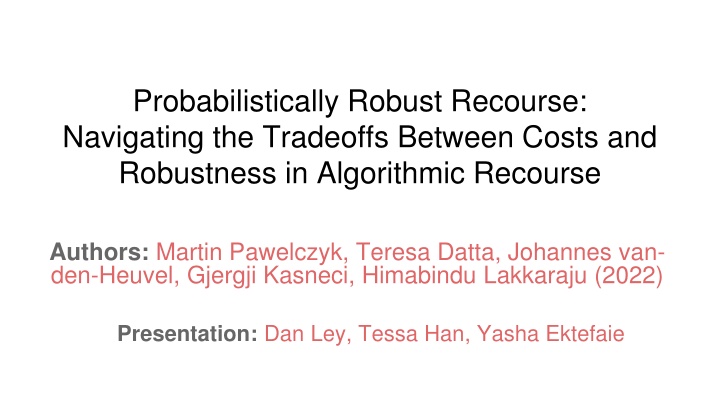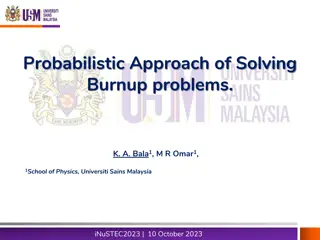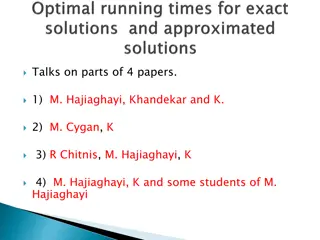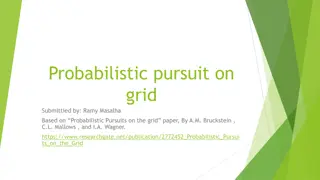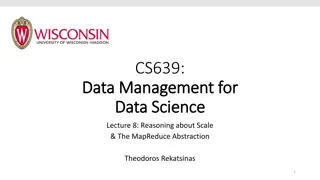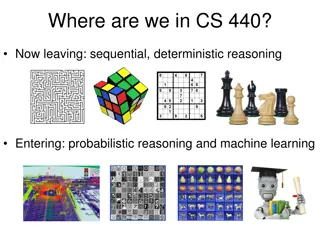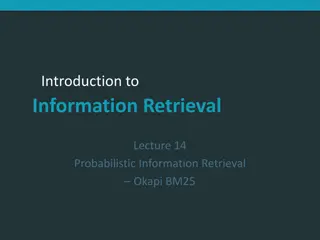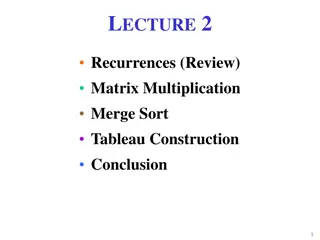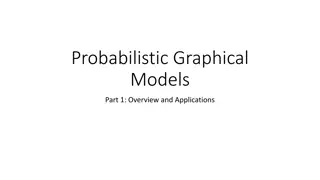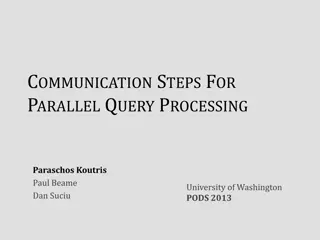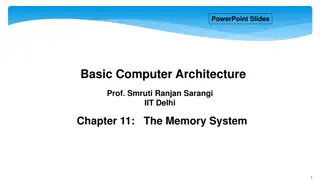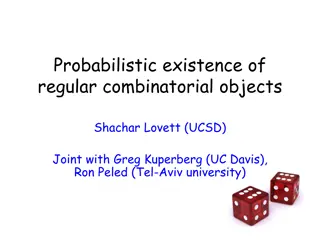Navigating Tradeoffs in Algorithmic Recourse: A Probabilistic Approach
This paper introduces PROBE, a Probabilistically Robust Recourse framework allowing users to balance cost and robustness in algorithmic recourse. Users can choose the recourse invalidation rate, enabling more tailored and efficient recourse management compared to existing methods. PROBE enhances cost-effectiveness and robustness, providing recourses at different invalidation rates.
Download Presentation

Please find below an Image/Link to download the presentation.
The content on the website is provided AS IS for your information and personal use only. It may not be sold, licensed, or shared on other websites without obtaining consent from the author.If you encounter any issues during the download, it is possible that the publisher has removed the file from their server.
You are allowed to download the files provided on this website for personal or commercial use, subject to the condition that they are used lawfully. All files are the property of their respective owners.
The content on the website is provided AS IS for your information and personal use only. It may not be sold, licensed, or shared on other websites without obtaining consent from the author.
E N D
Presentation Transcript
Probabilistically Robust Recourse: Navigating the Tradeoffs Between Costs and Robustness in Algorithmic Recourse Authors: Martin Pawelczyk, Teresa Datta, Johannes van- den-Heuvel, Gjergji Kasneci, Himabindu Lakkaraju (2022) Presentation: Dan Ley, Tessa Han, Yasha Ektefaie
Motivation Algorithmic recourse aims to provide users with actionable changes to move from a negative to a positive prediction in a machine learning (ML) model Typically, the minimum cost change is computed In the real-world, these changes are often implemented noisily E.g. an individual who was asked to increase their salary by $500 may get a promotion which comes with a raise of $505 or even $499.95 Or, as seen on Monday, changing certain factors may cause others to change
Related Work Counterfactual Explanations and Recourse A plethora of papers including Wachter et al. (2018) Summarised in Verma et al. (2020) Type of the underlying predictive model (e.g. tree based vs. differentiable classifier) Whether they encourage sparsity in counterfactuals (i.e. a small number of features) Whether counterfactuals should lie on the data manifold Whether the underlying causal relationships should be accounted for when generating counterfactuals Robustness to model/data shift: ROAR - Robust Algorithmic Recourse, Upadhyay et al. (2021) Robustness to input perturbations: Causal Algorithmic Recourse, Dominguez-Olmedo et al. (2022) All approaches generate recourses assuming that the prescribed recourses will be correctly implemented by users
Solution PROBE - Probabilistically Robust Recourse Allows users to manage the recourse cost vs. robustness trade-offs Users can choose the recourse invalidation rate Probability with which a recourse could get invalidated Baselines include: Upadhyay et al. (2021) - ROAR, targeting recourses that are robust to model changes Dominguez-Olmedo et al. (2022) - targeting recourses that are robust to input changes PROBE recourses are, compared to the baselines: Less costly than previous methods More robust to noisy implementations Able to provide recourses at various invalidation rates
Notation input space output space 0: unfavourable outcome 1: favourable outcome classifier inputs logits logits binary labels
General formulation of algorithmic recourse make CF have favourable outcome low cost Accounts for CF having favourable outcome and low cost Does not account for potential noise in the implemented counterfactual Addressed by this paper
Recourse invalidation rate probability distribution that captures noise in response where e.g.
Recourse invalidation rate aware objective function make CF have favourable outcome (seen before) make IR of CF close to target IR (new term) low cost (seen before) where target IR CF s IR
Approximation of recourse invalidation rate (Theorem 1) Problem: is not differentiable (used in objective function) Solution: use a first order approximation of where : counterfactual : logit at counterfactual 1. solve Proof sketch: 2. Use first order Taylor series to approximate logit 3. Calculate probability that normal r.v. is less than a value CDF
Approximation of recourse invalidation rate (Theorem 1): further analyses Proposition 1 Wachter et al. (2018) method for logistic regression Derive closed form solution for IR of CF Show how to make CF more robust Proposition 2 PROBE recourse incurs an additional cost (linear regression) Proposition 3 Upperbound on IR
Experimental Evaluation: Datasets considered Adult Dataset: Predict whether an individual has an income greater than 50,000 USD/year Give Me Some Credit: Predict whether an individual will experience financial distress within the next two years or not COMPAS: Predict if criminal is high or low risk of re-offending
Experimental Evaluations: Baselines considered Baseline Methods Growing Spheres (GS) Random search algorithm: generate observations until decision boundary is crossed then move greedily toward decision boundary AR (-LIME) Local interpretable model-agnostic explanations (LIME) Actional Recourse in Linear Models (AR) use integer programming Diverse Counterfactual Explanations (DICE) Promote diversity of counterfactual explanations Gradient General formulation of algorithmic recourse Adversarial Minmax Objectives Methods Robust Algorithm Recourse (ROAR) Recourse robust to model changes by generating counterfactuals that minimize worst-case loss over plausible model shifts Adversarial Robustness of Casual Algorithmic Recourse (ARAR) Recourse robust to features of individual (in the time individual seeks implement recourse other features may change)
Experimental Evaluation: Measures Used Average Cost (AC): Average cost for all prescribed recourses for the test set (implemented as l1-norm) Recourse Accuracy (RA): For all prescribed recourses what fraction results in the desired prediction Average IR (AIR): Average recourse invalidation rate for all prescribed recourses in test set
Conclusions, Future work First work to navigate tradeoff between recourse cost and robustness, give control to the user Experimental evidence demonstrates usefulness of framework and the existence of tradeoff Future work: generate recourse that is simultaneously robust to noise in inputs and shifts in model parameters
Discussions/Limitations Generate recourse that is simultaneously robust to noise in inputs and shifts in model parameters Is there not a tradeoff still? Would the user have to provide different robustness thresholds for the different aspects the method is robust with respect to? Or is there one threshold to rule them all? Would users be okay with this risk of defining r% invalidation? Bias? How does recourse relate to bias? In general this idea of cost being described as l1 distance across methods seems to be a major limitation. Not all features incur similar contributions to cost (i.e. getting a degree versus putting more money into your savings account, one is harder than the other). Cost is a difficult concept to quantify.
